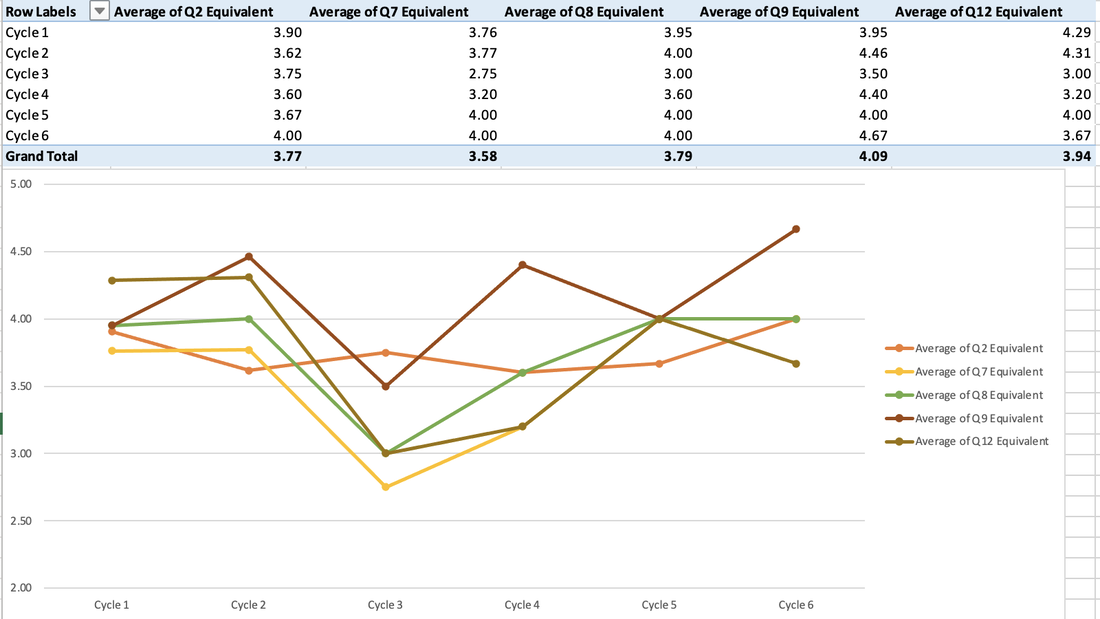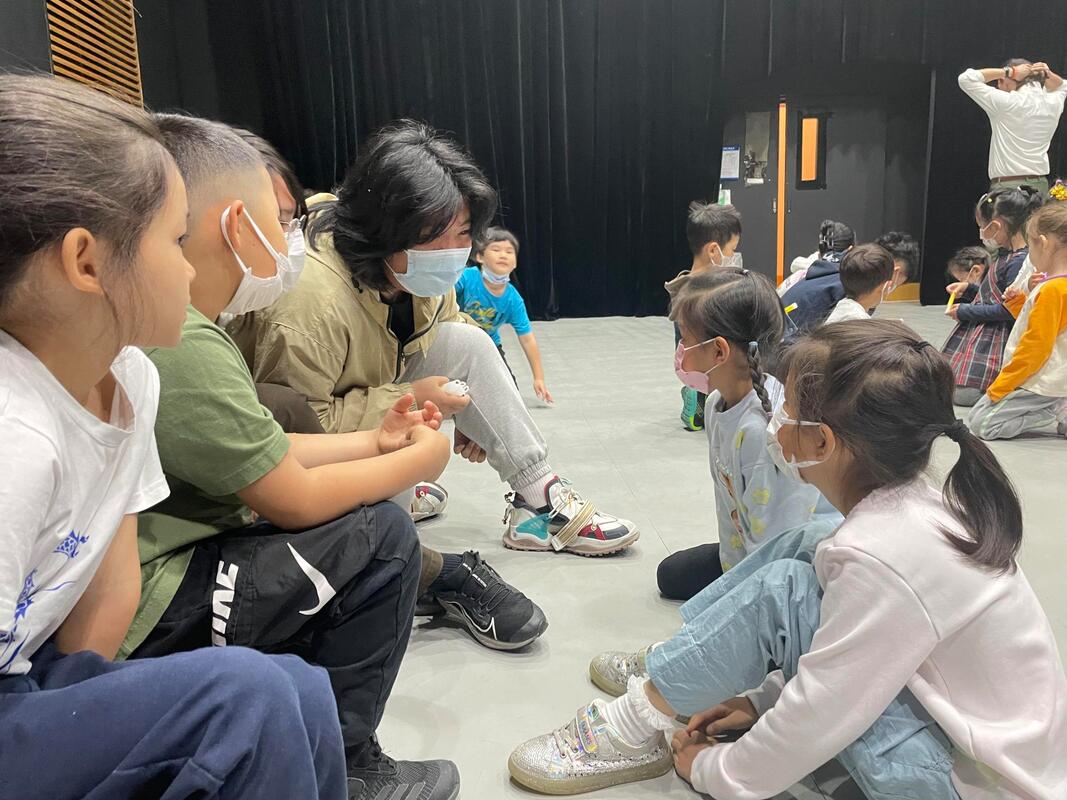|
For the past several years I have been working on integrating social and emotional learning (SEL) into my classroom. The inspiration for this came from a desire to include SEL in a real way as a part of regular classroom practice, no different from the content we teach. I completed a research paper entitled Social and Emotional Learning Self-assessment and its influence on Standards-based assessment. I also worked with on our school’s initial SEL scope and sequence team which informed my research as well as my own studies on the on the Interest Inventory, a project by the Aspire Survey folks. My approach is to provide students with self-assessment surveys based on SEL competencies once a school cycle (8 days at my current school) believing that regular, conscious thought about the competencies would improve overall performance and agency in the school. For the teacher, it helps me adjust my classroom aura to fit the general emotional state of my students. Students have a choice of six surveys. The surveys are anonymous and the feedback I receive comes in the form of pie and bar graphs. I write the surveys to be student friendly, that is, language is direct, and where appropriate, I remove pedagogical speak in place of teenager-speak. It should be noted I am approaching fifty so really it reads like dad jokes. The previous two school years I was making an attempt at keeping up but between all the regular responsibilities of teaching and the back-and-forth nature of online learning at our school, results were imprecise because of irregular data collection. However, this year I am happy to report that my performance has been much better, a result of dropping a few responsibilities in favour of doing this type of thing. The initial surveys were based on the IB Learner Profile and our school’s Student as a Learner Rubric; the latter similar to approaches to learning in the IB and other schools. Our school’s SEL scope and sequence has evolved, and I have used it to make more surveys about global citizenship, personal agency and responsibility; and identity. I have also used these surveys with two classes who participate in buddy classes with elementary school classmates. You can find a Word document with the questions I used and the original literature review at the bottom of this post. So now what? I am hesitant to say that has improved student learning, although I believe it has. My hesitation comes from the facts that, every student cohort is different, and I do believe that I have two very good cohorts at present. Also, nothing is new about the units I am teaching. I have been teaching them for four years now and reaching that Zen point where I know what’s happening and can adjust on the fly. Finally, I have not been keeping scientific data on any of this. Nonetheless, I stand by the assertion that it has improved student learning at the very least because it creates rapport between the students and I. This has been held up by psychologists smarter and more focused than I. So, the second semester has already begun and since this year school things seem to be working with the self-assessment survey approach I am going to take the next step. Fortunately, fate has provided just such an opportunity. Working with our school’s form and data guy, the fabulous Tony Fu I have been able to chart average response on several questions from the Myself and My Environment survey. You’ll notice a dip near cycle three. I thought to myself “What could be happening?” and so approached our school’s SEL counselors for some input. We discussed possibilities and reasons and looked at the calendar, but the strongest suggestion was to ask the students themselves, so I did. You can see their reasons to the right of the data. In general, lots of work inside school and lots of additional work related to but not a part of regular school. Little time for rest and enjoyment with friends, and the political climate. My school is in China and this coincided with the protests, lockdown, and the relationship between the USA and China (many of our students are Americans.) Our school calendar is approaching another such period. For IBDP students, mock exams and then exams, college acceptances, and final external assessments. For these students as well as the others we are entering a transition period. Including graduation, moving to new grades, some students leaving this community, teachers moving on (myself included,) and the new sports season is in full swing. Therefore, my approach will be to provide more opportunities for students to interact with one another in the classroom. We also have a new iteration of the buddy class coming up! Soliciting conversations with students about their work loads, and their experiences at tournaments (here’s hoping we win some,) giving them opportunities to do some low-stakes art fun, and taking them outside. As for the latter, I have no idea how I will work it into my lessons, but I’ll think of something and I am open to suggestions. What I am hoping to find is that there is a less of a dip mid-late March. I’ll report back on my Twitter at the least and hopefully here too. Check in again and feel free to use and adjust and distribute the surveys as you see fit. Don’t forget to cite your source – Mr. Allen is Cool dot com.
0 Comments
Over the past three years I have been doing something with my classes which now has become a mainstay of my educational practice which, I hope, is packed with a lot of fun. The first of our four Buddy Classes happened. I pair my Art 1 students, mostly ninth graders, with a class from the elementary school. This year one mono-lingual class and two dual language classes. Over the period of a school year the students meet four times, once for each of our corresponding units in Art 1. Right now the students are studying drawing, and for the Buddy Class we do light drawing. Light drawing is using a light source (glow sticks) and long exposure photography. I booked the black box, recruited the art and photography TA’s and we all got together for a heap of fun. It works like this: Students stand at one end of the room with glow sticks and the photographer sits at the other with the camera. Someone (me) turns off the lights and the students move the glow sticks in a pattern, the camera shutters stays open, we found eight seconds was the right time for our environment. When the shutter closes the path of the glow sticks has been recorded. The students are organized into groups, two HS students with 4-6 first grade students. At first they are let free to do what they want with the glow sticks but the challenges get increasingly complex. First try it out, second, shapes, third a scene, and we end with writing. HS students work together with and help organize the first grade students, although there was more than one instance of a first grade student organizing an HS student. In preparation the HS students are explained how light drawing works. We also have a class discussion about working with younger classmates. We poll the room for those who are older siblings and the those who are younger siblings. There is class discussion about effective and positive ways of dealing with younger students. I lend them a little expertise from my times as an elementary school teacher as well. After the event the students complete a survey about which techniques they used and what they will do next time. This type of experience is important for a few reasons. First, it provides my students a way to use what we have been studying in class from a teaching standpoint. It asks the high school students to think about gestural drawing in a way that requires understanding so that it can be explained. Second, it builds relationships across the school. The first-grade students explore a part of the school they are rarely in. They work with students and teachers from different divisions, and they are doing something with purpose. The HS students get to take a leadership role and learn how to organize an activity as well as listen to suggestions and turn those into ideas. To the first and second point simultaneously, the first-grade students will begin a unit on light in just a few weeks and already their teachers have asked if her students can interview mine. Finally, the social and emotional learning (SEL) benefits are put into action through class content. Our school’s SEL competencies include nurturing healthy relationships, through this way we are learning through the constructivist approach, that is doing it in the company of others. Some fun anecdotes: A fairly shy high school student (above) was observed being an excellent leader with young children. A first grade student wore her light up shoes on purpose, to add to the fun. Two days later the first grade students visited my classroom when they were making a map of the school. Their teacher told me they were hoping to meet their buddies. Sadly, their buddies were not present, but my diploma students were and the first graders came in to say hello. On the survey for the question inquiring about how much the activity was enjoyed, one student selected the “I want to be a first grade teacher" option. Our next buddy class will be happening in a month. The HS students will be studying painting and how art is an interdisciplinary subject. With the first grade students we will write Chinese calligraphy, make some winter-time paintings, and have a go at the very large paint brush (it’s really big, taller than most first grade students.). Stay tuned. If you have questions and comments please reach out. Be well and do good work!
|
AuthorGreetings all! Here are some blog posts about nifty teaching things. ArchivesCategories |
|||||||||||||||||||||||||||||||||||









 RSS Feed
RSS Feed